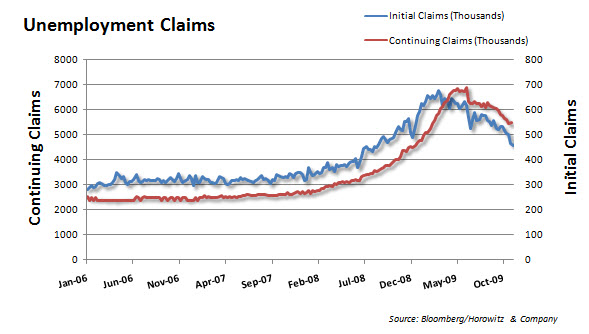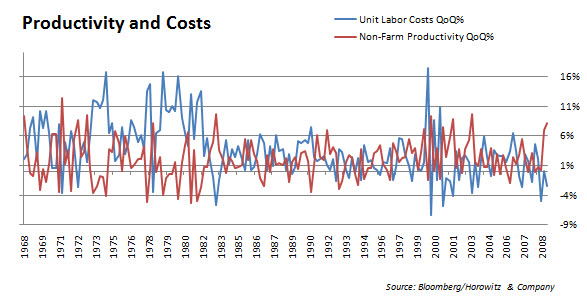Unemployment claims ebbed again and that is good. Initial claims came in under the expected amount and that is good too. Even continuing claims are trending lower, and that is good. But, to be honest, there is just so much fat you can cut off until there is only meat and bone left.
 On the other hand…. Productivity is rising toward record levels at the same time labor costs are dropping. To explain this we must consider what is occurring in our economy right now. First, as bottom line earnings (EPS) is the overwhelming focus for management, everything considered excess (even the kitchen sink) must go. We have seen this confirmed through the mass layoffs shown by the base unemployment rate north of 10%.
On the other hand…. Productivity is rising toward record levels at the same time labor costs are dropping. To explain this we must consider what is occurring in our economy right now. First, as bottom line earnings (EPS) is the overwhelming focus for management, everything considered excess (even the kitchen sink) must go. We have seen this confirmed through the mass layoffs shown by the base unemployment rate north of 10%.
 Second, since jobs are hard to come by, many employees will work much harder for much less in order to bring in a paycheck. Add to this the fact that technology has helped to replace workers and enhance output and we have a recipe for better profits…at the expense of payrolls. It looks better for the bottom line, at least for the company, but not for workers.
Second, since jobs are hard to come by, many employees will work much harder for much less in order to bring in a paycheck. Add to this the fact that technology has helped to replace workers and enhance output and we have a recipe for better profits…at the expense of payrolls. It looks better for the bottom line, at least for the company, but not for workers.
Historically, during economic slowdowns (recessions), management does a good job at tightening their belts which results in productivity gains with lower labor costs – it really makes perfect sense.
If only it could stay that way. What ends up happening though is that just past the time of crisis, hiring increases – driving costs go up. Subsequently productivity declines and labor costs rise.
Look at the early 1970’s and you can see that during the recession, productivity spiked higher while labor costs dipped. The same during 1982-1983’s downturn and 2000-2002.
The problem occurs just past the end of the recessionary periods when companies, still having difficulty balancing income and expenses, need to consider adding payrolls. Earnings are at risk and in many times, take a hit. Perhaps the excess optimism creates a false sense of security, just as excess negativity forced companies to cut back.
The cycle is working well into our forecast of a potential double-dip toward the second half of 2010 which will coincide with corporate earnings coming under pressure.
___
Disclosure: Horowitz & Company clients may hold positions of securities mentioned as of the date published.
















